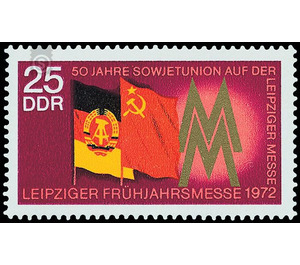Commemorative stamp series - Germany / German Democratic Republic 1972 - 25 Pfennig
Theme: Art & Culture
| Country | Germany / German Democratic Republic |
| Issue Date | 1972 |
| Face Value | 25.00 |
| Color | red |
| Perforation | K 14 |
| Printing Type | Photogravure |
| Stamp Type | Postage stamp |
| Item Type | Stamp |
| Chronological Issue Number | 1486 |
| Chronological Chapter | GER-DDR |
| SID | 506897 |
| In 23 Wishlists | |
Leipziger Spring Fair 1972 At the Leipzig Spring Fair 1972, the Ministry of Posts and Telecommunications of the German Democratic Republic issued two multicolored special postage stamps. 50 years of the Soviet Union at the Leipzig Trade Fair For the 1972 Leipzig Spring Fair, the 50th anniversary of the first USSR participation in the Leipzig Trade Fair is celebrated. On this occasion, the Ministry of Posts and Telecommunications of the German Democratic Republic issued these two special stamps. The 25-pfennig value shows the two state flags of the GDR and the USSR. He thus symbolizes the unbreakable and ever-deepening friendship and cooperation between the two states and their peoples. The Leipziger Messe, whose world-famous MM (Mustermesse) was included in the design of both brands, has made its contribution since 1946, which the Soviet Foreign Trade Minister Nikolai S. Patolitschew characterized as saying: "With each passing year, their significance for development increases foreign trade relations between the Soviet Union and the German Democratic Republic ". The historical reason for producing these stamps dates back to 1922. At that time, the young Soviet state participated for the first time with a small pavilion and two exhibition stands for wooden toys and folk artifacts. With this first participation in a capitalist country, the Soviet Union expressed its readiness for peaceful coexistence and favored the development of economic relations between the two countries. At that time, mainly such export goods as animal and vegetable raw materials were exhibited; mainly furs, hemp, flax, medicinal plants, bristles and wood. The Leipzig Trade Fair became an impressive reflection of the development of the Soviet economy - from the very beginning at that time to its global status today. If one compares the fair offer of that time with that of the jubilee year, then this becomes clear. The Soviet Jubilee Exhibition for the 1972 Leipzig Spring Fair is dominated by engineering products, scientific equipment, models of nuclear power plants, cement factories and electronics, electrical and electronic products and original Soviet spacecraft models, including the Luna-16 automatic interplanetary station, the Soyuz orbital station and the Lunochod moon mobile -l. Historical merits, the Soviet Union has acquired the revival of the Leipzig Fair after 1945. After the suppression of fascism, the Leipzig Trade Fair, which was badly damaged during World War II, was rebuilt. Order No. 73 of the Soviet Military Administration paved the way for the opening of the "First Leipzig Peace Fair", which took place from 8 to 12 May 1946. At this fair, the Soviet Union was the only foreign exhibitor. Since then, the Leipzig Trade Fair has made a valuable contribution to the development and deepening of foreign trade relations between the USSR and the GDR. After the founding of the GDR, the Soviet Union participated for the first time in its own pavilion at the Leipzig Spring Fair in 1950 with around 13,000 square meters of exhibition space. In 1950, the mutual foreign trade turnover was about 1.5 billion marks. In the following 20 years it has increased tenfold. In the course of the years 1971 to 1975, the volume of mutual trade will increase by a further 56 percent compared to the previous planning year. This is the largest trade turnover ever achieved between two countries. The presentation of new products, the study of experiences u.a. through the exchange of information at the trade fair stands and specialist lectures, negotiations on current and future deliveries as well as the conclusion of new contracts - all this and other activities characterize the trade fair participation of the socialist states, especially the member states of the Council for Mutual Economic Assistance. With the decisions of the VIII. Party Congress of the Socialist Unity Party of Germany and of the XXV. Meeting of the Council for Mutual Economic Assistance complex program are the Leipzig Fair new, far-reaching tasks in support of socialist economic integration.


